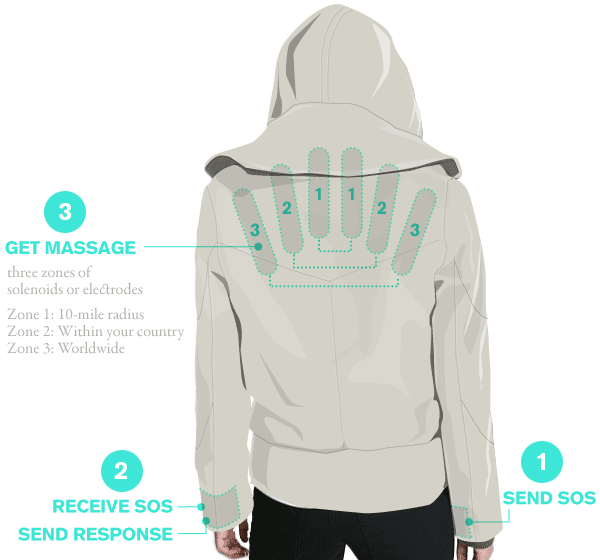The phenomenon of social networking allows fragmented friends and families to keep in touch and empowers users to share their lives with the world. Four female students from MIT think that such a medium could also help to alleviate something else that many members of the global community share and suffer from – stress. The SOS: stress outsourced system consists of wearable units containing wireless signaling technology. Should a wearer feel the burden of stress, sending out an SOS to fellow users around the globe generates a haptic massage from the relief signals sent in response.
Peggy Chi, Keywon Chung, Xiao Xiao and Carnaven Chiu from MIT have created a system where wearers of special clothing receive a soothing massage upon receipt of crowdsourced responses from a network of global users. Each SOS unit would consist of three modules. One would be used to send out a signal to other users indicating that help is needed to find some stress relief. Another would receive requests for help and notify the wearer that a response is required. The last module would consist of the massage zones themselves.

The basic idea is that a stressed-out wearer sends out an anonymous SOS via the signaling module at the wrist. This cry for help is received by other SOS system users and they can choose to ignore or to help out by sending back a haptic response. After the second or so it will take each recipient on the network to respond, the clothing generates an accumulated therapeutic full back and shoulder massage for the originator of the plea.
According to the designers, the principle is based on an old Korean proverb which says: "if ten people give you a spoonful of rice, you will end up with a real meal." Similarly, the system proposes that every ten responses generates a massage stroke. Exactly where a stroke is delivered to a user depends on the global origin of the signaled response to the SOS. Signals identified as local result in a strong massage stroke aimed at the spinal massage modules. Signals from overseas are weaker and aimed at the outer modules.
So that users don't get overwhelmed by requests for help, the system would incorporate both a subtle signal notification mechanism and the ability to completely switch off. It is also proposed that some sort of web interface be created to cater for users who are unable to get to their hardware or for those who don't actually own any hardware but would still like to help reduce stress on the network.

A prototype jacket has been created as a proof of concept using signaling and response modules in the wristbands and three sets of massage motors connected to a three switch system. The current example uses bulky motors and massage pads attached to the outside of the fabric but the designers have pointed out that the various modules used in any production system could take on a variety of forms.
They could also be incorporated into such things as watches or bracelets, a pillow or seat or region specific locations of the body, such as the lower or upper back. The prototype has not, as yet, been connected to the Internet either but is controlled by selectively activating and deactivating switches.
More information about the concept is available at the project website.















